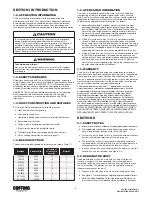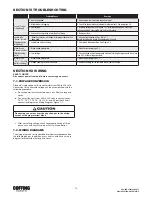
4
EC3-680-3 February 2017
Order # 5041558-0 & 5041679-0
DO NOT PULL AT AN ANGLE. BE SURE HOIST AND LOAD ARE
IN A STRAIGHT LINE.
DO NOT USE LOAD CHAIN AS A SLING.
USE HOIST PROPERLY
Be sure hoist is solidly held in the uppermost part of the support
hook arc.
Be sure hoist and load are in a straight line.
Do not pull at an angle.
Be sure load is hooked securely. Do not tip load the hook. Do not
load hook latch. Hook latch is to prevent detachment of load under
slack chain conditions only.
Do not use load chain as a sling. Such usage damages the chain
and lower hook.
Do not operate with hoist head resting against any object. Lift the
load gently. Do not jerk it.
DO NOT LIFT PEOPLE OR LOADS OVER PEOPLE
LIFT PROPERLY
Do not lift co-workers with a
hoist.
Make sure everyone is clear of
the load when you lift.
Do not remove or obscure
operational warning notices.
MAINTAIN PROPERLY
CLEANING
Hoists should be kept clean and free of dust, dirt, moisture, etc.,
which will in any way affect the operation or safety of the equipment.
LUBRICATION
Chain should be properly lubricated.
AFTER REPAIRS
Carefully operate the hoist
before returning it to full service.
HOIST SAFETY IS UP TO YOU...
DO NOT LIFT MORE THAN RATED LOAD.
CHOOSE THE RIGHT HOIST FOR THE JOB...
Choose a hoist with the capacity for the
job. Know the capacities of your hoists and
the weight of your loads. Then match them.
The application, the size and type of
load, the attachments to be used and
the period of use must also be taken into
consideration in selecting the right hoist for
the job.
Remember, the hoist was designed to
ease our burden and carelessness not only
endangers the operator, but in many cases,
a valuable load.
DO NOT OPERATE DAMAGED OR MALFUNCTIONING HOIST.
DO NOT OPERATE WITH TWISTED, KINKED, OR DAMAGED CHAIN.
INSPECT
All hoists should be visually inspected before
use, in addition to regular, periodic maintenance
inspections.
Inspect hoists for operations warning notices and
legibility.
Deficiencies should be noted and brought to the attention of
supervisors. Be sure defective hoists are tagged and taken out of
service until repairs are made.
Under no circumstances should you operate a malfunctioning hoist.
Check for gouged, twisted, distorted
links and foreign material. Do not
operate hoists with twisted, kinked, or
damaged chain links.
Load chain should be properly
lubricated.
Hooks that are bent, worn, or whose
openings are enlarged beyond normal
throat opening should not be used. If
latch does not engage throat opening
of hook, hoist should be taken out of
service.
Chains should be checked for deposits
of foreign material which may be carried
into the hoist mechanism.
Check brake for evidence of slippage under load.
VIOLATIONS OF ANY OF THE WARNINGS LISTED MAY RESULT IN SERIOUS PERSONAL INJURY TO THE OPERATOR
OR NEARBY PERSONNEL BY NATURE OF RELEASED LOAD OR BROKEN HOIST COMPONENTS.


























